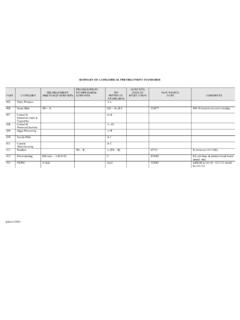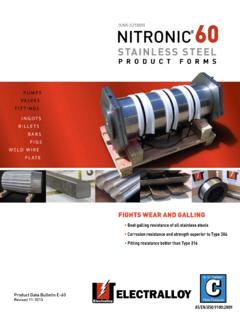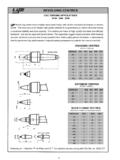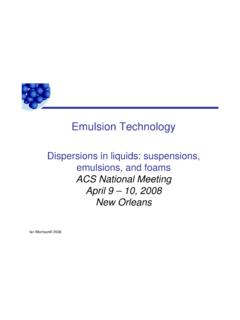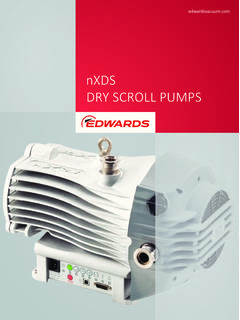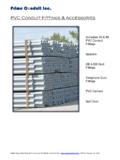Transcription of Pr eserv ativ es in Liquid Pharmaceutical Pr …
1 14uid Pharmaceutical products are admin-istered to the pediatric Preservatives have been commonly usedas additives in Pharmaceutical products,cosmetics,and preparationsare particularly susceptible to microbialgrowth because of the nature of preparations are pro-tected by the addition of preservativesthat prevent the alteration and degrada-tion of the product are mainly effective incontrolling mold,inhibiting yeastgrowth,and protecting against antimicrobial andantifungal properties make them anintegral part of the product the most commonly usedpreservatives in the conservation of liq-uid Pharmaceutical preparations aresodium benzoate,potassium sorbate,andmethyl hydroxybenzoate (methyl-paraben).Their typical allowed concen-trations range respectively , ,and (w/w).1 The purpose of this study is todetermine the amount of the formerpreservatives in Liquid pharmaceuticalsfor quality assurance purposes as well asfor patient interest isgiven to preservatives as recent studieshave reported serious side effects associ-ated with these , & 2,2009 The Journal of Applied ResearchPreservatives in LiquidPharmaceutical Preparations Chawki Boukarim,* Sarah Abou Jaoud ,Rita Bahnam,Roula Barada,Soula KyriacosDepartment of Pharmaceutical Sciences,School of Pharmacy,Lebanese American University,Byblos, WORDS.
2 Preservatives,sodiumbenzoate,potassium sorbate,methyl-paraben,quality benzoate,potassium sorbate,and methyl hydroxybenzoate are com-monly used as preservatives in liquidpharmaceutical pur-pose of this study is to determine theamount of the aforementioned preserva-tives in Pharmaceutical products,assome recent studies have reported seri-ous side effects associated with theingestion of these con-tent of 37 Liquid Pharmaceutical prod-ucts were simultaneously determined byhigh performance Liquid were analyzed in trip-licate for their preservative contentusing a sensitive and reproducibleHPLC method modified in our levels were found to falloutside the typical allowed concentra-tion range for 70% of the samples,withsome exhibiting significantly higher reason behind suchfindings is unclear,and could be due topoor quality control or to intentionallyextend the shelf-life of the findings highlight issues related toquality control and to patient s on patient health need tobe evaluated,especially since most liq-The Journal of Applied Research , & 2,200915tions such as rash,urticaria,,and contactdermatitis have been reported after top-ical application of potassium sorbate,-methylparaben,- and sodium benzoate-containing ,2,3 Other sideeffects have been reported after inges-tion of medications containing thesepreservatives such as the allergic poten-tial and estrogenic potential ofparabens,2,4or the genotoxic activitypotential of sodium AND METHODST hirty seven Liquid pharmaceuticalpreparations were purchased from ran-domly selected pharmacies in all preparations were labeled withrespect to their preservative content.
3 19,8,and 1 preparation(s) were labeled fortheir methylparaben,sodium benzoate,and potassium sorbate content respec-tively,while 14 preparations were unla-beled with respect to one or brands of theliquid preparations were coded usingletters (A to AL).Acetonitrile (HPLC grade) and sodi-um acetate (analytical grade) were pur-chased from Sigma, ,potassium sorbate,andmethylparaben standards were pur-chased from Fluka, wereused to prepare standard working solu-tions using distilled water,to obtainstock solutions of 1 g/L solutions were used to preparesolutions of lower concentrations (50,100,200,and 400 mg/L) to build the cali-bration correlation coeffi-cients were above in all were analyzed in tripli-cate for their preservative content usingasensitive and reproducible HPLC method 5-8modified in our HPLC system consisted of LC-10pump (Shimadzu),a variable ultravioletdetector monitor set at 229 nm(Shimadzu,SPD-10),and a ChromatopacShimadzu (C-R8A) was done using a pre-packedstainless steel column (15 cm x cm)filled with Shimpack C18 10 m Silica(Waters,Germany)
4 ,and the flow ratewas set to mL per minute for sodiumbenzoate and potassium sorbate and 2mL/min for preci-sion of the assay method was determinedby calculating the relative standard devi-ation (inter- and intra-days) of the peakareas obtained after repeated injections(n=3) of all standard rela-tive standard deviations of the areaswere found to be less than ,whichconfirms the precision of the 1: Concentration (%w/w) of Sodium Benzoate in labeled % (w/w).Only Product K con-tained the preservative in concentrationsabove the typical allowed concentrations(Figure 2).Two products exhibited sodi-um benzoate concentrations below typi-cal allowed ,as much as 50% of the pharmaceuticalproducts containing sodium benzoate areformulated at a pH>5,at which the pre-servative is for potassium sorbate,the onlylabeled product included a higheramount of unlabeledsamples were found to contain potassi-um sorbate as a shownin Figure 3,products E and O exceededthe typical allowed concentrations for samples were labeled ashaving methylparaben as a was found in concentrations rangingfrom % (w/w).
5 Only onelabeled product included methylparabenin concentration exceeding the maximalallowed amount and 14 out of the 19samples had concentrations below theallowed range (Figure 4).None of theunlabeled samples exhibited concentra-tions exceeding the typical allowedrange (Figure 5).All,however,had theirmethylparaben concentration below theallowed , & 2,2009 The Journal of Applied Research16 One gram of each of the samples wasaccurately weighed and transferred to a100mL volumetric phasewas added to volume and phase was an aqueous solutionof acetonitrile M sodium acetatebuffer (20:80,v/v),adjusted to a pH acetic mobile phase wasfiltered through a m filter anddegassed before microlitersof the filtrate were injected into retention times for sodium ben-zoate,potassium sorbate and methyl-paraben were , ,and minutes, AND DISCUSSION In the eight samples labeled as contain-ing sodium benzoate as a preservative,concentrations of the latter rangedbetween - % (w/w).
6 Two sam-ples (A and G) included sodium ben-zoate in amounts significantly exceedingthe typical allowed concentrations (upto four-fold difference) whereas twoother products had a sodium benzoateconcentration slightly exceeding thatrange (Figure 1).After screening the 12 unlabeled sam-ples,six were found to contain sodiumbenzoate in concentrations ranging fromFigure2: Concentration (%w/w) of Sodium Benzoate in unlabeled Journal of Applied Research , & 2,200917 CONCLUSIONP reservatives levels were found to falloutside the typical allowed concentra-tion range for 70% of the samples,withsome exhibiting significant higher present study highlightsthe high amount of preservatives thatmay be found in some Liquid pharma-ceutical reason behindsuch finding is unclear and could be dueto poor quality control or to intentional-ly extend the shelf life of the to patients health needtobe evaluated,especially since mostliquid Pharmaceutical products areadministered to the pediatric work was supported by a grantfrom the Research Council at theLebanese American.
7 The Science andPractice ofPharmacy,21stedition,Lippincott Williams &Wilkins,Philadelphia, , , of esters of p-hydroxybenzoicacid (parabens). (7):985-1015 (2005). Report on the SafetyAssessment of Benzyl Alcohol,Benzoic Acid,and Sodium (Suppl 3):23-50 (2001). , , , of the health aspects ofmethyl paraben:a review of the published Chem (10):1335-73(2002). of combined p-hydroxy benzoic acid preservatives in a liquidpharmaceutical formulation by :207-213 (2004). , , ,et of ambroxol hydrochloride,methylparaben and benzoic acid in pharma-ceutical preparations based on sequentialinjection technique coupled with :287-293(2006). Jr., high-performance Liquid chromatography methodfor the analysis of sodium benzoate andpotassium sorbate in ofChromatography :299-304 (2000). , ,and HPLC determinationof preservatives in (Vilnius). , (2002).

